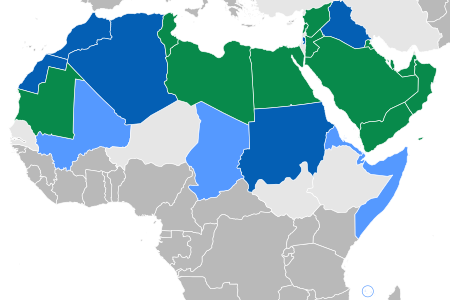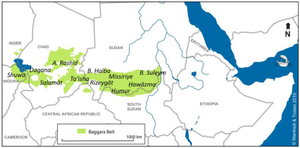
The history of Islam concerns the political, social, economic, military, and cultural developments of the Islamic civilization. Most historians believe that Islam originated with Muhammad's mission in Mecca and Medina at the start of the 7th century CE, although Muslims regard this time as a return to the original faith passed down by the Abrahamic prophets, such as Adam, Noah, Abraham, Moses, David, Solomon, and Jesus, with the submission (Islām) to the will of God.

The Middle East is a geopolitical region encompassing the Arabian Peninsula, the Levant, Turkey, Egypt, Iran, and Iraq. The term came into widespread usage as a replacement of the term Near East beginning in the early 20th century. The term "Middle East" has led to some confusion over its changing definitions, and being seen as too Eurocentric. The region includes the vast majority of the territories included in the closely associated definition of West Asia, but without the South Caucasus, and additionally includes all of Egypt and all of Turkey.

The Umayyad Caliphate or Umayyad Empire was the second caliphate established after the death of the Islamic prophet Muhammad and was ruled by the Umayyad dynasty. Uthman ibn Affan, the third of the Rashidun caliphs, was also a member of the clan. The family established dynastic, hereditary rule with Mu'awiya I, the long-time governor of Greater Syria, who became caliph after the end of the First Fitna in 661. After Mu'awiya's death in 680, conflicts over the succession resulted in the Second Fitna, and power eventually fell to Marwan I, from another branch of the clan. Syria remained the Umayyads' main power base thereafter, with Damascus as their capital.

The Arab world, formally the Arab homeland, also known as the Arab nation, the Arabsphere, or the Arab states, comprises a large group of countries, mainly located in Western Asia and Northern Africa. While the majority of people in the Arab world are ethnically Arab, there are also significant populations of other ethnic groups such as Berbers, Kurds, Somalis and Nubians, among other groups. Arabic is used as the lingua franca throughout the Arab world.

Pakistan is a multilingual country with over 70 languages spoken as first languages. The majority of Pakistan's languages belong to the Indo-Iranian group of the Indo-European language family.

Abu al-Abbas Abd Allah ibn Muhammad ibn Ali ibn Abd Allah, known by his laqab al-Saffah, was the first caliph of the Abbasid Caliphate, one of the longest and most important caliphates in Islamic history.

Arabization or Arabicization is a sociological process of cultural change in which a non-Arab society becomes Arab, meaning it either directly adopts or becomes strongly influenced by the Arabic language, culture, literature, art, music, and ethnic identity as well as other socio-cultural factors. It is a specific form of cultural assimilation that often includes a language shift. The term applies not only to cultures, but also to individuals, as they acclimate to Arab culture and become "Arabized". Arabization took place after the Muslim conquest of the Middle East and North Africa, as well as during the more recent Arab nationalist policies toward non-Arab minorities in modern Arab states, such as Algeria, Iraq, Syria, Egypt, Bahrain, and Sudan.
A national language is a language that has some connection—de facto or de jure—with a nation. The term is applied quite differently in various contexts. One or more languages spoken as first languages in the territory of a country may be referred to informally or designated in legislation as national languages of the country. National languages are mentioned in over 150 world constitutions.
Official multilingualism is the policy adopted by some states of recognizing multiple languages as official and producing all official documents, and handling all correspondence and official dealings, including court procedure, in these languages. It is distinct from personal multilingualism, the capacity of a person to speak several languages.
An Islamic state has a form of government based on sharia law. As a term, it has been used to describe various historical polities and theories of governance in the Islamic world. As a translation of the Arabic term dawlah islāmiyyah it refers to a modern notion associated with political Islam (Islamism). Notable examples of historical Islamic states include the state of Medina, established by the Islamic prophet Muhammad, and the Arab caliphate which continued under his successors and the Umayyads.
The Islamization of Iran was the spread of Islam in formerly Sassanid Iran as a result of the Muslim conquest of the empire in 633–654. It was a long process by which Islam, though initially rejected, eventually spread among the population on the Iranian Plateau. Iranian peoples have maintained certain pre-Islamic traditions, including their language and culture, and adapted them with Islamic codes. These two customs and traditions merged as the "Iranian Islamic" identity.

Iraqis are people who originate from the country of Iraq.

New Persian, also known as Modern Persian is the current stage of the Persian language spoken since the 8th to 9th centuries until now in Greater Iran and surroundings. It is conventionally divided into three stages: Early New Persian, Classical Persian, and Contemporary Persian.
Sulayman is an Arabic name of the Biblical king and Islamic prophet Solomon meaning "man of peace", derived from the Hebrew name Shlomo.
Persianization or Persification, is a sociological process of cultural change in which a non-Persian society becomes "Persianate", meaning it either directly adopts or becomes strongly influenced by the Persian language, culture, literature, art, music, and identity as well as other socio-cultural factors. It is a specific form of cultural assimilation that often includes a language shift. The term applies not only to cultures, but also to individuals, as they acclimate to Persian culture and become "Persianized" or "Persified".

The Abbasid Revolution, also called the Movement of the Men of the Black Raiment, was the overthrow of the Umayyad Caliphate, the second of the four major Caliphates in Islamic history, by the third, the Abbasid Caliphate. Coming to power three decades after the death of the Islamic prophet Muhammad and immediately after the Rashidun Caliphate, the Umayyads were an Arab empire ruling over a population which was overwhelmingly non-Arab. Non-Arabs were treated as second-class citizens regardless of whether or not they converted to Islam, and this discontent cutting across faiths and ethnicities ultimately led to the Umayyads' overthrow. The Abbasid family claimed descent from al-Abbas, an uncle of Muhammad.
The Muslim conquest of Khorasan, or Arab conquest of Khorasan, was the last phase of the heavy war between the Arab Rashidun caliphate against the Sassanid Empire & Later vassal states of Tang dynasty














